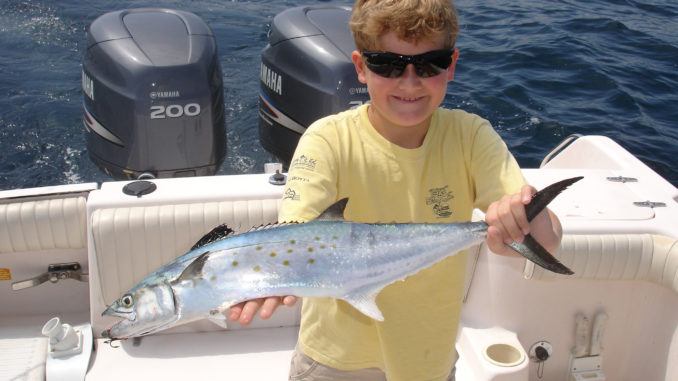
Bait-and-switch will trick big mackerel
The heat is on in Murrells Inlet this month on both land and sea, and that means it’s time to bait-and-switch Spanish mackerel, pitching baits to big fish.
J Baisch of Fishfull Thinking Guide Service looks forward to the tail end of summer of those mackerel.
“August and September are the two best months to catch Spanish on live bait,” said Baisch. (843-902-0356) “We find a relatively calm day, fill the livewell with mullet and head to the tips of the jetties or one of the nearshore artificial reefs.”
Spanish mackerel will congregate around places where bait is abundant, and the inlet and artificial reefs are prime locations. Baisch likes the Pawley’s Reef and the 3-Mile Reef, but he will go to any of the reefs, especially if they don’t hold many barracudas.
What kind of bait you use is critical to bait-and-switch where Spanish are the target; mullet is the only bait that will keep mackerel near the surface.
“The mullet’s escape route is up, while other baitfish, like menhaden, swim down when pressured,” said Baisch, who likes to take hundreds of baitfish on trips for Spanish. It takes plenty, he said, to spoon-feed fish until the big fish take the bait.
“A full-grown Spanish mackerel is at the top of the game and one of the most intelligent fish around,” he said.
Spanish mackerel are leader-shy, and older, bigger fish are especially spooky. Baisch tosses a handful of mullet well away from the boat and watches until they get eaten. He continues to feed the Spanish until they begin to expect it and recognize its source.
“The big Spanish will quickly figure out what is happening and where the free food is coming from. And when they do, they will not let them get 10 yards out before they crush them,” he said.
That’s when Baisch slips in a hooked mullet alongside one of the free swimmers.
“You don’t have but a 5-second window to get your bait out there. I watch the free swimmers, and they let me know when it is time to pitch the hooked baits,” he said.
When the bait starts getting nervous, it is a sign the Spanish are moving in for the kill. Baisch hooks a mullet just behind the dorsal fin with a No. 4 or No. 6 treble hook and 4 inches of 44-pound hard wire. He keep the hooked mullet in the water next to the boat until the time is right, then pitches it next to the free swimmers.
Baisch can fool mackerel at any time of day, but the best, he said, is early in the morning or late in the evening.
“Low-light conditions allow us to conceal the leader from these fish and con them into eating one of our hooked baits. It is a real unique way to catch them, but we have a lot of fun doing it at the end of the summer,” he said.




Be the first to comment